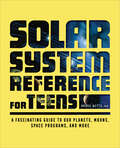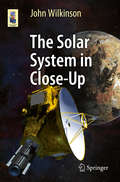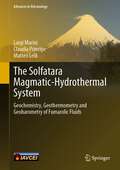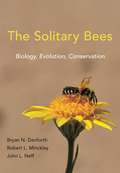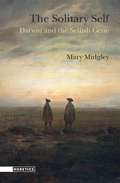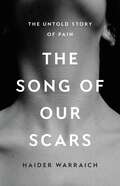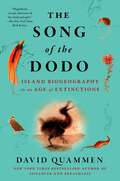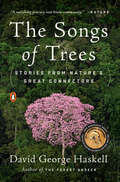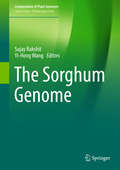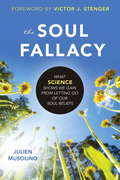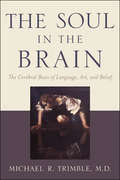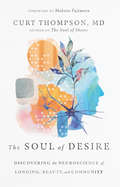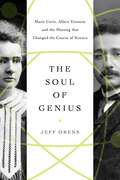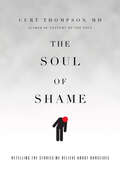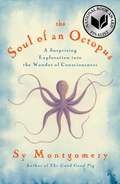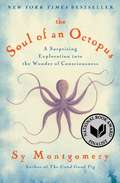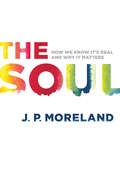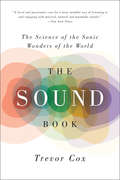- Table View
- List View
The Solar System Reference for Teens: A Fascinating Guide to Our Planets, Moons, Space Programs, and More
by Dr. Bruce BettsTake a tour of our solar system with this guide for teens ages 12 to 16 From the moons of Jupiter to the surface of Mars, our solar system is home to a multitude of wild, weird worlds. Crack open this solar system book and embark on a journey through space as you meet key figures in history, explore careers in astronomy, uncover some of the solar system's biggest mysteries, and more. Tons of images—Bring celestial objects into focus through more than 160 images, illustrations, and diagrams that provide a close-up look into our solar system and how it works. Fascinating facts—Did you know the Moon gets farther from Earth each year at about the same rate that your fingernails grow? Discover all sorts of awe-inspiring facts about our solar system's planets, moons, and more. Exciting exploration—Learn about important historical achievements and technological developments—including missions to different parts of the solar system—and get tips for your own stargazing sessions. Explore all the cool stuff in our solar system with this accessible reference guide for teens.
The Solar System in Close-Up
by John WilkinsonIn response to the new information gained about the Solar System from recent space probes and space telescopes, the experienced science author Dr. John Wilkinson presents the state-of-the art knowledge on the Sun, solar system planets and small solar system objects like comets and asteroids. He also describes space missions like the New Horizon's space probe that provided never seen before pictures of the Pluto system; the Dawn space probe, having just visited the asteroid Vesta, and the dwarf planet Ceres; and the Rosetta probe inorbit around comet 67P/Churyumov-Gerasimenko that has sent extraordinary and most exciting pictures. Those and a number of other probes are also changing our understanding of the solar system and providing a wealth of new up close photos. This book will cover all these missions and discuss observed surface features of planets and moons like their compositions, geisers, aurorae, lightning phenomena etc. Presenting the fascinating aspects of solar system astronomy this book is a complete guide to the Solar System for amateur astronomers, students, science educators and interested members of the public.
The Solar System-Volume 1
by David G. Fisher and Richard R. EricksonHeavily illustrated and detailed, and completely up-to-date, The Solar System, Revised Edition provides an A to Z format on over 180 major topics on Earth's solar system. All essays from the previous edition have been fully expanded and revised to include additional knowledge gained from recent interplanetary missions, including the missions of Galileo, and the most recent Mars missions.
The Solar System: Discover the mysteries of our sun and neighboring planets (Space Explorers)
by Sophie AllanDiscover our expansive solar system in this breathtaking journey into space. This charming book is the perfect introduction for young readers who want to learn about our local star - the Sun - and the planets that orbit it. The Solar System covers space in thrilling detail and is the perfect book for space lovers everywhere. Packed with mind-blowing facts, this incredible book of the solar system is perfect for space lovers everywhere. This fascinating guide introduces 7-9 year-olds to the birth of the Sun and the solar system, then continues on a journey through space. They discover the smallest planet, rocky Mercury, which is closest to the Sun, and Venus, the hottest planet. There is also Mars, with its polar ice caps and volcanoes, and Jupiter, with its swirling storm clouds. Then readers venture further into space to explore the icy giants of outer space. This wonderful solar system book offers:- In-depth information, backed up by space photography, probe images, illustrations, and fun diagrams.- Striking illustrations, making this title a perfect gift, as well as a solid reference book. - Easy-to-digest sections, each filled with incredible facts and visuals.STEM learning, with key topics for 7-9 year-olds: labeled images of each of the planets, clear step-by-step visuals to show the birth of our solar system, accessible facts about space missions.Boasting beautiful illustrations by artist Dawn Cooper, combined with up-to-date images from space agencies such as NASA and ESA, info panels, timelines, and diagrams, that help demystify and explain the spectacles of space, this is the ideal book for budding astronauts.At DK, we believe in the power of discovery.So why stop there?If you like The Solar System, then why not complete the collection? Take a trip into space and discover the mysteries of Earth&’s closest neighbor with The Moon. <P><P><i>Advisory: Bookshare has learned that this book offers only partial accessibility. We have kept it in the collection because it is useful for some of our members. Benetech is actively working on projects to improve accessibility issues such as these.</i>
The Solfatara Magmatic-Hydrothermal System: Geochemistry, Geothermometry and Geobarometry of Fumarolic Fluids (Advances in Volcanology)
by Luigi Marini Claudia Principe Matteo LelliThis book includes innovative gas-geothermometers and geobarometers, which are urgently needed to estimate the increasingly higher temperatures and pressures present at depth below the Solfatara volcano, owing to its on-going unrest. Therefore, in this book, new gas geoindicators, applicable up to ca. 1000°C and 3 kbar, have been implemented and applied to Solfatara fluids. The innovations of this book include: methane, having a sluggish behavior, was treated separately from fast-reacting carbon monoxide; deviations from the ideal gas behavior were considered; the effects of reaction kinetics were taken into account. This was possible because a dataset including many geochemical parameters and extending from 1983 to 2020 with a good sampling frequency is available for Solfatara, making it a case history probably unique worldwide. Nevertheless, the gas geoindicators described in this book can be applied to other similar systems. Thus, this book is of interest to many scientists studying gas geochemistry, geothermometry, and geobarometry for volcanic surveillance and the mitigation of the volcanic risk.
The Solitary Bees: Biology, Evolution, Conservation
by Bryan N. Danforth Robert L. Minckley John L. Neff Frances FawcettThe most up-to-date and authoritative resource on the biology and evolution of solitary beesWhile social bees such as honey bees and bumble bees are familiar to most people, they comprise less than 10 percent of all bee species in the world. The vast majority of bees lead solitary lives, surviving without the help of a hive and using their own resources to fend off danger and protect their offspring. This book draws on new research to provide a comprehensive and authoritative overview of solitary bee biology, offering an unparalleled look at these remarkable insects.The Solitary Bees uses a modern phylogenetic framework to shed new light on the life histories and evolution of solitary bees. It explains the foraging behavior of solitary bees, their development, and competitive mating tactics. The book describes how they construct complex nests using an amazing variety of substrates and materials, and how solitary bees have co-opted beneficial mites, nematodes, and fungi to provide safe environments for their brood. It looks at how they have evolved intimate partnerships with flowering plants and examines their associations with predators, parasites, microbes, and other bees. This up-to-date synthesis of solitary bee biology is an essential resource for students and researchers, one that paves the way for future scholarship on the subject.Beautifully illustrated throughout, The Solitary Bees also documents the critical role solitary bees play as crop pollinators, and raises awareness of the dire threats they face, from habitat loss and climate change to pesticides, pathogens, parasites, and invasive species.
The Solitary Self: Darwin and the Selfish Gene
by Mary MidgleyRenowned philosopher Mary Midgley explores the nature of our moral constitution to challenge the view that reduces human motivation to self-interest. Midgley argues cogently and convincingly that simple, one-sided accounts of human motives, such as the 'selfish gene' tendency in recent neo-Darwinian thought, may be illuminating but are always unrealistic. Such neatness, she shows, cannot be imposed on human psychology. She returns to Darwin's original writings to show how the reductive individualism which is now presented as Darwinism does not derive from Darwin but from a wider, Hobbesian tradition in Enlightenment thinking. She reveals the selfish gene hypothesis as a cultural accretion that is just not seen in nature. Heroic independence is not a realistic aim for Homo sapiens. We are, as Darwin saw, earthly organisms, framed to interact constantly with one another and with the complex ecosystems of which we are a tiny part. For us, bonds are not just restraints but also lifelines.
The Somatosensory System: Deciphering the Brain's Own Body Image
by Randall J. NelsonExploring new and past research in the understanding of how the brain deals with its own body image, this book provides a review of pertinent literature and offers comprehensive descriptions of technical approaches. The material includes new frameworks for the conceptualization of the system's representations, scientific and clinical applications that stem from these approaches based on the new concepts, and a discussion of tools used to study the interface of the brain and the body. The book provides computational strategies for sensorimotor integration of the mammalian brain and includes algorithms for the design and implementation of haptic interfaces and tactile displacement.
The Song of Our Scars: The Untold Story of Pain
by Haider WarraichA doctor&’s personal and unsparing account of how modern medicine&’s failure to understand pain has made care less effectiveIn The Song of Our Scars, physician Haider Warraich offers a bold reexamination of the nature of pain, not as a simple physical sensation, but as a cultural experience.Warraich, himself a sufferer of chronic pain, considers the ways our notions of pain have been shaped not just by science but by politics and power, by whose suffering mattered and whose didn&’t. He weaves a provocative history from the Renaissance, when pain transformed into a medical issue, through the racial legacy of pain tolerance, to the opiate epidemics of both the nineteenth and twenty-first centuries, to the cutting edge of present-day pain science. The conclusion is clear: only by reckoning with both pain&’s complicated history and its biology can today&’s doctors adequately treat their patients&’ suffering.Trenchant and deeply felt, The Song of Our Scars is an indictment of a broken system and a plea for a more holistic understanding of the human body.
The Song of the Dodo: Island Biogeography in an Age of Extinctions
by David QuammenDavid Quammen's book, The Song of the Dodo, is a brilliant, stirring work, breathtaking in its scope, far-reaching in its message -- a crucial book in precarious times, which radically alters the way in which we understand the natural world and our place in that world. It's also a book full of entertainment and wonders. In The Song of the Dodo, we follow Quammen's keen intellect through the ideas, theories, and experiments of prominent naturalists of the last two centuries. We trail after him as he travels the world, tracking the subject of island biogeography, which encompasses nothing less than the study of the origin and extinction of all species. Why is this island idea so important? Because islands are where species most commonly go extinct -- and because, as Quammen points out, we live in an age when all of Earth's landscapes are being chopped into island-like fragments by human activity. Through his eyes, we glimpse the nature of evolution and extinction, and in so doing come to understand the monumental diversity of our planet, and the importance of preserving its wild landscapes, animals, and plants. We also meet some fascinating human characters. By the book's end we are wiser, and more deeply concerned, but Quammen leaves us with a message of excitement and hope.
The Songs of Trees: Stories from Nature's Great Connectors
by David George HaskellThe author of the Pulitzer Prize finalist The Forest Unseen visits with nature’s most magnificent networkers — trees “Here is a book to nourish the spirit. The Songs of Trees is a powerful argument against the ways in which humankind has severed the very biological networks that give us our place in the world. Listen as David Haskell takes his stethoscope to the heart of nature - and discover the poetry and music contained within.” -- Peter Wohlleben, author of The Hidden Life of TreesDavid Haskell’s award-winning The Forest Unseen won acclaim for eloquent writing and deep engagement with the natural world. Now, Haskell brings his powers of observation to the biological networks that surround all species, including humans. Haskell repeatedly visits a dozen trees around the world, exploring the trees’ connections with webs of fungi, bacterial communities, cooperative and destructive animals, and other plants. An Amazonian ceibo tree reveals the rich ecological turmoil of the tropical forest, along with threats from expanding oil fields. Thousands of miles away, the roots of a balsam fir in Canada survive in poor soil only with the help of fungal partners. These links are nearly two billion years old: the fir’s roots cling to rocks containing fossils of the first networked cells. By unearthing charcoal left by Ice Age humans and petrified redwoods in the Rocky Mountains, Haskell shows how the Earth’s climate has emerged from exchanges among trees, soil communities, and the atmosphere. Now humans have transformed these networks, powering our societies with wood, tending some forests, but destroying others. Haskell also attends to trees in places where humans seem to have subdued “nature” – a pear tree on a Manhattan sidewalk, an olive tree in Jerusalem, a Japanese bonsai– demonstrating that wildness permeates every location. Every living being is not only sustained by biological connections, but is made from these relationships. Haskell shows that this networked view of life enriches our understanding of biology, human nature, and ethics. When we listen to trees, nature’s great connectors, we learn how to inhabit the relationships that give life its source, substance, and beauty.
The Sonic Breach: The Drone Pursuit; The Sonic Breach; Restricted Access; The Virtual Vandal (Tom Swift Inventors' Academy #2)
by Victor AppletonThe Hardy Boys meets Alex Rider in this second novel in a brand-new series starring everyone’s favorite inventor—Tom Swift!Tom gets to take all sorts of cool classes at the Swift Academy of Science and Technology, but robotics may be the one he is most excited for. Their teacher is holding a battling robot tournament, and Tom has to build a machine that will come out on top. With the final battle coming up, Tom and his friends need as much time as possible to refine their masterpiece. But the rest of their teachers have been giving so many pop quizzes that they can barely focus in class, never mind concentrate on the tournament. Naturally, everyone is frustrated with the trend…until a mysterious new phone app appears. If students get pop quizzes during first period, they can warn everyone else about it by getting their phones to emit a high-pitched sound—a mosquito alarm—that adults can’t hear. Tom is unsure about the whole thing, but it technically isn’t cheating, right? But when someone changes the app to break all the rules, the ethics aren’t debatable anymore. The longer the perpetrator remains unknown, the more harshly teachers treat all the students, and the pressure won’t stop until Tom and his friends track down the person behind the app takeover.
The Sorghum Genome
by Sujay Rakshit Yi-Hong WangThis book provides insights into the current state of sorghum genomics. It particularly focuses on the tools and strategies employed in genome sequencing and analysis, public and private genomic resources and how all this information is leading to direct outcomes for plant breeders. The advent of affordable whole genome sequencing in combination with existing cereal functional genomics data has enabled the leveraging of the significant novel diversity available in sorghum, the genome of which was fully sequenced in 2009, providing an unmatched resource for the genetic improvement of sorghum and other grass species. Cultivated grain sorghum is a food and feed cereal crop adapted to hot and dry climates, and is a staple for 500 million of the world's poorest people. Globally, sorghum is also an important source of animal feed and forage, an emerging biofuel crop and model for C4 grasses, particularly genetically complex sugarcane.
The Soul Fallacy
by Victor J. Stenger Julien MusolinoMost Americans believe they possess an immaterial soul that will survive the death of the body. In sharp contrast, the current scientific consensus rejects the traditional soul, although this conclusion is rarely discussed publicly. In this book, a cognitive scientist breaks the taboo and explains why modern science leads to this controversial conclusion. In doing so, the book reveals the truly astonishing scope and power of scientific inquiry, drawing on ideas from biology, psychology, neuroscience, philosophy, and the physical sciences. Much more than chronicling the demise of the traditional soul, the book explores where soul beliefs come from, why they are so widespread culturally and historically, how cognitive science offers a naturalistic alternative to religious conceptions of mind, and how postulating the existence of a soul amounts to making a scientific claim.Although the new scientific view of personhood departs radically from traditional religious conceptions, the author shows that a coherent, meaningful, and sensitive appreciation of what it means to be human remains intact. He argues that we do not lose anything by letting go of our soul beliefs and that we even have something to gain. Throughout, the book takes a passionate stand for science and reason. It also offers a timely rejoinder to recent claims that science supports the existence of the soul and the afterlife.
The Soul in the Brain: The Cerebral Basis of Language, Art, and Belief
by Michael R. TrimbleIn this provocative study, Michael R. Trimble, M.D., tackles the interrelationship between brain function, language, art—especially music and poetry—and religion. By examining the breakdown of language in several neuropsychiatric disorders, he identifies brain circuits that are involved with metaphor, poetry, music, and religious experiences. Drawing on this body of evidence, Trimble argues that religious experiences and beliefs are explicable biologically and relate to brain function, especially of the nondominant hemisphere.Inspired by the writings and reflections of his patients—many of whom have epilepsy, psychosis, or affective disorders—Trimble asks how the human species, so enamored of its own logic and critical facilities, has held from the dawn of civilization strong religious beliefs and a reverence for the arts. He explores topics such as the phenomena of hypergraphia and hyper-religiosity, how religious experiences and poetic expression are neurologically linked with our capacity to respond to music, and how neuropsychiatric disorders influence behaviors related to artistic expression and religiosity by disturbing brain function.With the sensitivity of a dedicated doctor and the curiosity of an accomplished scholar, Trimble offers an insightful analysis of how the study of people with paradigmatical neuropsychiatric conditions can be the cornerstone to unraveling some of the mysteries of the cerebral representations of our highest cultural experiences.
The Soul of Desire: Discovering the Neuroscience of Longing, Beauty, and Community
by Curt ThompsonWe are people of desire. In The Soul of Desire, psychiatrist Curt Thompson suggests that underneath all our longings is the desire to be known—and what's more, that this fundamental yearning manifests itself in our deep need to make things of beauty, revealing who we are to others. Desire and beauty go hand in hand. But both our craving to be known and our ability to create beauty have been marred by trauma and shame, collapsing our imagination for what God has for us and blinding us to the possibility that beauty could ever emerge from our ashes. Drawing on his work in interpersonal neurobiology and clinical practice, Thompson presents a powerful picture of the capacity of the believing community to reshape our imaginations, hold our desires and griefs together, and invite us into the beauty of God’s presence. The Soul of Desire is a mature, creative work, weaving together neuroscience and spiritual formation to open up new horizons for thinking not only about the nature of the mind, but about what it means to be human.
The Soul of Genius: Marie Curie, Albert Einstein, and the Meeting that Changed the Course of Science
by Jeffrey OrensA prismatic look at the meeting of Marie Curie and Albert Einstein and the impact these two pillars of science had on the world of physics, which was in turmoil. In 1911, some of the greatest minds in science convened at the First Solvay Conference in Physics, a meeting like no other. Almost half of the attendees had won or would go on to win the Nobel Prize. Over the course of those few days, these minds began to realize that classical physics was about to give way to quantum theory, a seismic shift in our history and how we understand not just our world, but the universe. At the center of this meeting were Marie Curie and a young Albert Einstein. In the years preceding, Curie had faced the death of her husband and soul mate, Pierre. She was on the cusp of being awarded her second Nobel Prize, but scandal erupted all around her when the French press revealed that she was having an affair with a fellow scientist, Paul Langevin. The subject of vicious misogynist and xenophobic attacks in the French press, Curie found herself in a storm that threatened her scientific legacy. Albert Einstein proved an supporter in her travails. They had an instant connection at Solvay. He was young and already showing flourishes of his enormous genius. Curie had been responsible for one of the greatest discoveries in modern science (radioactivity) but still faced resistance and scorn. Einstein recognized this grave injustice, and their mutual admiration and respect, borne out of this, their first meeting, would go on to serve them in their paths forward to making history. Curie and Einstein come alive as the complex people they were in the pages of The Soul of Genius. Utilizing never before seen correspondance and notes, Jeffrey Orens reveals the human side of these brilliant scientists, one who pushed boundaries and demanded equality in a man&’s world, no matter the cost, and the other, who was destined to become synonymous with genius.
The Soul of Shame: Retelling the Stories We Believe About Ourselves
by Curt ThompsonThe Gospel Coalition Top Books of 2015 in Faith and WorkHearts Minds Bookstore's Best Books of 2015, Applied Theology, Basic Christian Living, Whole Life DiscipleshipWe're all infected with a spiritual disease. Its name is shame.Whether we realize it or not, shame affects every aspect of our personal lives and vocational endeavors. It seeks to destroy our identity in Christ, replacing it with a damaged version of ourselves that results in unhealed pain and brokenness. But God is telling a different story for your life.Psychiatrist Curt Thompson unpacks the soul of shame, revealing its ubiquitous nature and neurobiological roots. He also provides the theological and practical tools necessary to dismantle shame, based on years of researching its damaging effects and counseling people to overcome those wounds.Thompson's expertise and compassion will help you identify your own pains and struggles and find freedom from the lifelong negative messages that bind you. Rewrite the story of your life and embrace healing and wholeness as you discover and defeat shame's insidious agenda.
The Soul of an Octopus: A Playful Exploration Into the Wonder of Consciousness
by Sy MontgomeryIn this astonishing book from the author of the bestselling memoir The Good Good Pig, Sy Montgomery explores the emotional and physical world of the octopus-a surprisingly complex, intelligent, and spirited creature-and the remarkable connections it makes with humans. Sy Montgomery's popular 2011 Orion magazine piece, "Deep Intellect," about her friendship with a sensitive, sweet-natured octopus named Athena and the grief she felt at her death, went viral, indicating the widespread fascination with these mysterious, almost alien-like creatures. Since then Sy has practiced true immersion journalism, from New England aquarium tanks to the reefs of French Polynesia and the Gulf of Mexico, pursuing these wild, solitary shape-shifters. Octopuses have varied personalities and intelligence they show in myriad ways: endless trickery to escape enclosures and get food; jetting water playfully to bounce objects like balls; and evading caretakers by using a scoop net as a trampoline and running around the floor on eight arms. But with a beak like a parrot, venom like a snake, and a tongue covered with teeth, how can such a being know anything? And what sort of thoughts could it think? The intelligence of dogs, birds, and chimpanzees was only recently accepted by scientists, who now are establishing the intelligence of the octopus, watching them solve problems and deciphering the meaning of their color-changing camouflage techniques. Montgomery chronicles this growing appreciation of the octopus, but also tells a love story. By turns funny, entertaining, touching, and profound, The Soul of an Octopus reveals what octopuses can teach us about consciousness and the meeting of two very different minds.
The Soul of an Octopus: A Surprising Exploration Into the Wonder of Consciousness
by Sy Montgomery'Sy Montgomery&’s The Soul of an Octopus does for the creature what Helen Macdonald&’s H Is for Hawk did for raptors' New Statesman'Charming and moving...with extraordinary scientific research' Guardian'An engaging work of natural science... There is clearly something about the octopus&’s weird beauty that fires the imaginations of explorers, scientists, writers' Daily Mail In 2011 Sy Montgomery wrote a feature for Orion magazine entitled 'Deep Intellect' about her friendship with a sensitive, sweet-natured octopus named Athena and the grief she felt at her death. It went viral, indicating the widespread fascination with these mysterious, almost alien-like creatures. Since then, Sy has practised true immersion journalism, from New England aquarium tanks to the reefs of French Polynesia and the Gulf of Mexico, pursuing these wild, solitary shape-shifters. Octopuses have varied personalities and intelligence they show in myriad ways: endless trickery to escape enclosures and get food; jetting water playfully to bounce objects like balls; and evading caretakers by using a scoop net as a trampoline and running around the floor on eight arms. But with a beak like a parrot, venom like a snake, and a tongue covered with teeth, how can such a being know anything? And what sort of thoughts could it think? The intelligence of dogs, birds and chimpanzees was only recently accepted by scientists, who now are establishing the intelligence of the octopus, watching them solve problems and deciphering the meaning of their colour-changing camouflage techniques. Montgomery chronicles this growing appreciation of the octopus, but also tells a love story. By turns funny, entertaining, touching and profound, The Soul of an Octopus reveals what octopuses can teach us about consciousness and the meeting of two very different minds.
The Soul of an Octopus: A Surprising Exploration into the Wonder of Consciousness
by Sy MontgomeryFinalist for the National Book Award for Nonfiction * New York Times Bestseller * A Huffington Post Notable Nonfiction Book of the Year * One of the Best Books of the Month on Goodreads * Library Journal Best Sci-Tech Book of the Year * An American Library Association Notable Book of the Year &“Sy Montgomery&’s The Soul of an Octopus does for the creature what Helen Macdonald&’s H Is for Hawk did for raptors.&” —New Statesman, UK &“One of the best science books of the year.&” —Science Friday, NPR A New York Times bestseller from the author of The Good Good Pig, this &“fascinating…touching…informative…entertaining&” (The Daily Beast) book explores the emotional and physical world of the octopus—a surprisingly complex, intelligent, and spirited creature—and the remarkable connections it makes with humans.In pursuit of the wild, solitary, predatory octopus, popular naturalist Sy Montgomery has practiced true immersion journalism. From New England aquarium tanks to the reefs of French Polynesia and the Gulf of Mexico, she has befriended octopuses with strikingly different personalities—gentle Athena, assertive Octavia, curious Kali, and joyful Karma. Each creature shows her cleverness in myriad ways: escaping enclosures like an orangutan; jetting water to bounce balls; and endlessly tricking companions with multiple “sleights of hand” to get food. Scientists have only recently accepted the intelligence of dogs, birds, and chimpanzees but now are watching octopuses solve problems and are trying to decipher the meaning of the animal’s color-changing techniques. With her “joyful passion for these intelligent and fascinating creatures” (Library Journal Editors’ Spring Pick), Montgomery chronicles the growing appreciation of this mollusk as she tells a unique love story. By turns funny, entertaining, touching, and profound, The Soul of an Octopus reveals what octopuses can teach us about the meeting of two very different minds.
The Soul's Code: In Search of Character and Calling
by James HillmanPlato and the Greeks called it "daimon," the Romans "genius," the Christians "guardian angel." Today we use the terms heart, spirit, and soul. To James Hillman, the acknowledged intellectual source for Thomas Moore's bestselling sensation Care of the Soul, it is the central and guiding force of his utterly compelling "acorn theory"--in which each life is formed by a unique image, an image that is the essence of that life and calls it to a destiny, just as the mighty oak's destiny is written in the tiny acorn. In this new look at age-old themes, Hillman provides a radical, frequently amusing, and highly accessible path to realization through an extensive array of examples. He urges his readers to discover the "blueprints" particular to their own individual lives, certain that there is more to life than can be explained by genetics or environment. As he says, "We need a fresh way of looking at the importance of our lives." What The Soul's Code offers is an inspirational, positive approach to life--a way of seeing, and a way of recovering what has been lost of our intrinsic selves.
The Soul: How We Know It's Real and Why It Matters
by J. P. MorelandIn a culture in which science is believed to hold the answers to every question, spiritual realities like the soul are often ignored or ridiculed. We are told that neuroscience holds the key to explaining every aspect of human behavior. Yet Christian philosopher J. P. Moreland argues that Scripture, sound philosophical reasoning, and everyday experience all point to the reality of an immaterial soul. Countering the arguments of both naturalists and Christian scholars who embrace a material-only view of humanity, Moreland demonstrates why it is both biblical and reasonable to believe humans are essentially spiritual beings. He also describes the various components of the soul and how Christians can nurture their souls as disciples of Christ. Moreland shows that neuroscience and the soul are not competing explanations of human activity, but that both coexist and influence one another.
The Soul: How We Know It's Real and Why It Matters
by J. P. MorelandIn a culture in which science is believed to hold the answers to every question, spiritual realities like the soul are often ignored or ridiculed. We are told that neuroscience holds the key to explaining every aspect of human behavior. Yet Christian philosopher J. P. Moreland argues that Scripture, sound philosophical reasoning, and everyday experience all point to the reality of an immaterial soul. Countering the arguments of both naturalists and Christian scholars who embrace a material-only view of humanity, Moreland demonstrates why it is both biblical and reasonable to believe humans are essentially spiritual beings. He also describes the various components of the soul and how Christians can nurture their souls as disciples of Christ. Moreland shows that neuroscience and the soul are not competing explanations of human activity, but that both coexist and influence one another.
The Sound Book: The Science of the Sonic Wonders of the World
by Trevor Cox"A lucid and passionate case for a more mindful way of listening. . . . Anyone who has ever clapped, hollered or yodeled at an echo will delight in [Cox's] zestful curiosity."--New York Times Trevor Cox is on a hunt for the sonic wonders of the world. A renowned expert who engineers classrooms and concert halls, Cox has made a career of eradicating bizarre and unwanted sounds. But after an epiphany in the London sewers, Cox now revels in exotic noises--creaking glaciers, whispering galleries, stalactite organs, musical roads, humming dunes, seals that sound like alien angels, and a Mayan pyramid that chirps like a bird. With forays into archaeology, neuroscience, biology, and design, Cox explains how sound is made and altered by the environment, how our body reacts to peculiar noises, and how these mysterious wonders illuminate sound's surprising dynamics in everyday settings--from your bedroom to the opera house. The Sound Book encourages us to become better listeners in a world dominated by the visual and to open our ears to the glorious cacophony all around us.
